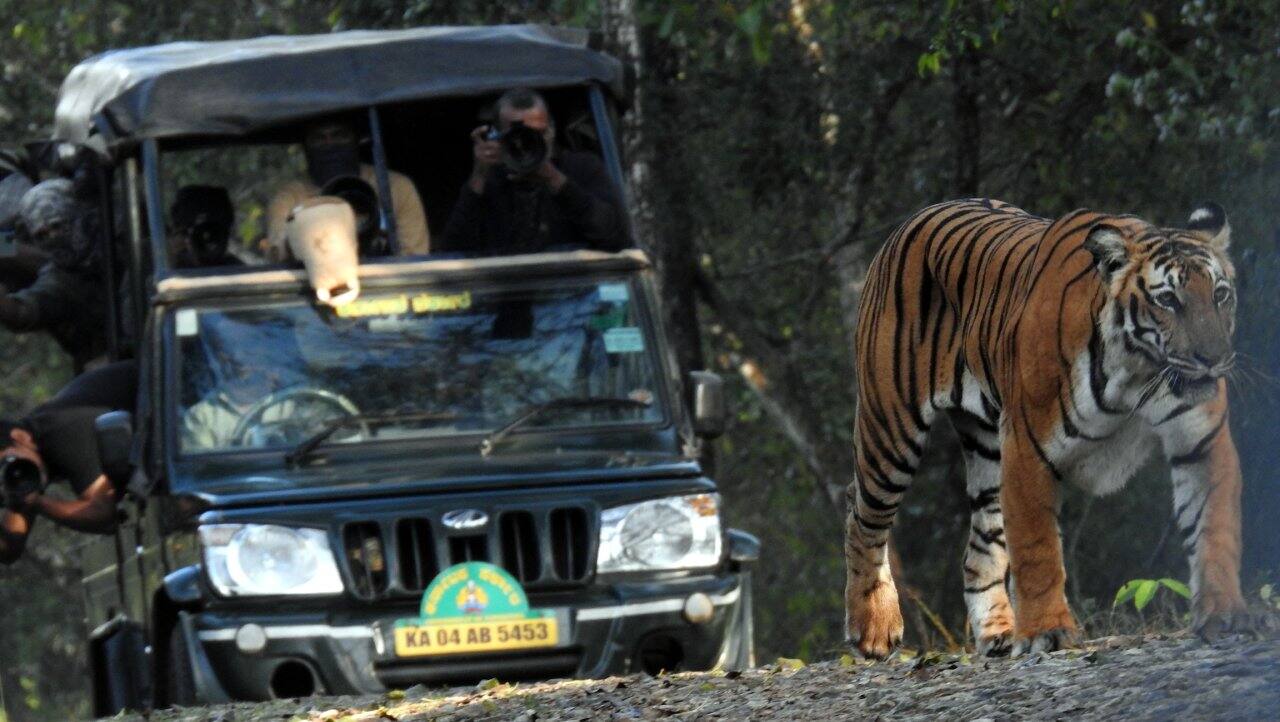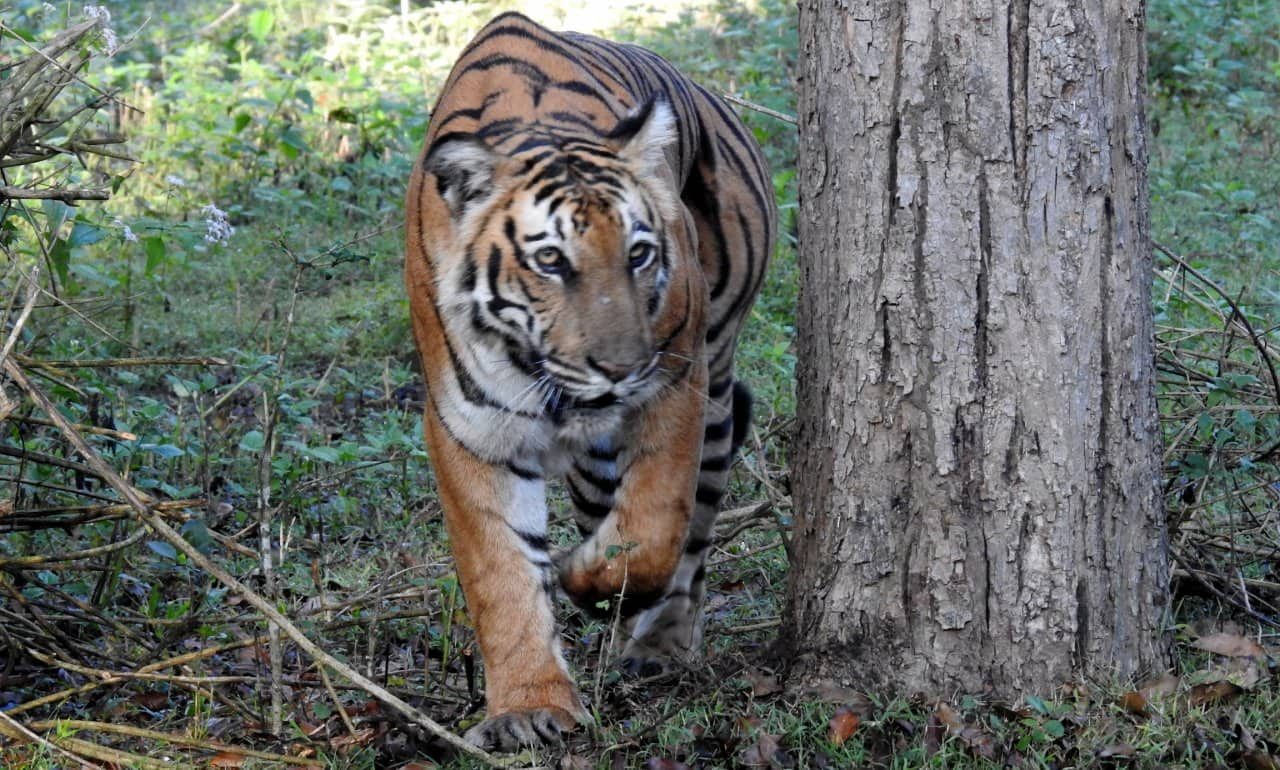



The latest tiger census puts the number of tigers in India at 3,167, up from 2,967 in 2018. Naturally, this is reason for cheer. Ahead of International Tiger Day, observed each year on July 29, here is a list of 10 India's best tiger reserves that allow you to see this magnificent animal in its natural habitat.
Nagarhole/KabiniSpread over close to 848 sq. km., Nagarhole Tiger Reserve has the highest tiger concentration in south India. Nagarhole (nagar means serpent and hole means river in Kannada) has the famed Kabini river flowing in the western side of the park. The reserve became part of Project Tiger in 2003 and was declared a core tiger habitat in 2007. The reserve has implemented a tiger conservation plan for the core, buffer, and corridor areas as well. The government of Karnataka conducts all the safaris in the mornings and evenings through the jungle lodges. The safari is a great way to see the tiger and other animals and birds.
Stay at JLR Kings Sanctuary.
 Of the 53 tiger reserves in India, Nagarjunasagar Srisailam Tiger Reserve in Andhra Pradesh is one of the largest, with 3,721 sq km of core area and over 2,200 sq. km. of buffer. (Photo by Bindu Gopal Rao)Pench
Of the 53 tiger reserves in India, Nagarjunasagar Srisailam Tiger Reserve in Andhra Pradesh is one of the largest, with 3,721 sq km of core area and over 2,200 sq. km. of buffer. (Photo by Bindu Gopal Rao)PenchThe jungles of Pench are said to be the inspiration behind Rudyard Kipling's The Jungle Book. Named after the river Pench that flows through it, the tiger reserve is spread over 758 sq. km. In 1999, the Pench Tiger Project got notified as a tiger reserve of India and in 2017 it was notified as a critical tiger habitat. Incidentally, Pench is one of the three tiger reserves that won the TX2 Award for a fivefold increase in its tiger population from 9 in 2006 to 44 in 2021. There are day and night safaris at Pench that are great to spot the tiger.
Stay at Kohka Wilderness Camp
KazirangaA UNESCO World heritage site, Kaziranga is known for its rare one-horned rhinoceros but is also a tiger reserve. Spread over 430 sq. km., the tiger population here has seen a steady increase in numbers - it was declared a tiger reserve in 2006. The Royal Bengal tigers are seen in the Agoratoli range of the park. You can do both jeep safaris as well as elephant safaris here. The western zone is recommended for tiger sightings. Over 100 tigers have been recorded in this region, making it a unique site.
Stay at Wild Mahseer
CorbettThe Jim Corbett National Park is India's oldest - it was established in 1936 - and this is where Project Tiger was first launched in 1973. The park has an open-roof canter and mid-sized vehicles that enter the buffer zones of the park for morning and evening safaris. Spread over 1,318 sq.km. with the Ramganga river flowing through it, the park is said to have a high density of tigers. This has prompted the National Tiger Conservation Authority to add some of the surrounding areas as part of the buffer zone. There are several monitoring measures and camera traps in place for tiger conservation as well.
Stay at Taj Corbett Resort & Spa
SatpuraThe Satpura Tiger Reserve, spread over a whopping 2,133.307 sq. km., is among one of the country's oldest tiger reserves. In 2000, the government of India announced Satpura as part of Project Tiger. There are both jeep and elephant safaris offered here as well as boating in the Denwa river. With its rich biodiversity and varied flora and fauna, the park is a great example of the central Indian highlands ecosystem. To ensure conservation, monitoring and camera trap ID to create the database of tigers is also ongoing.
Stay at Denwa Backwater Escape, by Pugdundee Safaris
PilibhitThe Pilibhit Tiger Reserve, in the Pilibhit district and Shahjahanpur district of Uttar Pradesh, has a landscape comprising sal forests, tall grasslands, and swamps. It was declared as the country's 45th Tiger Reserve Project in 2008 due to its unique ecosystem of woodlands, riverine and grasslands. The Gomti river is said to originate from this reserve. With a high density of tigers, Pilibhit is interlinked with Corbett's Surahi range, Shuklaphanta National Park's Lagga-Bagga and Dudhwa's Kishanpur Wildlife Sanctuary. Notified in 2014 as part of Project Tiger, the conservation activities here include patrolling, addressing man-animal conflict and also developing the buffer and corridor areas.
Stay at Fortune Walkway Mall
Tadoba-AndhariMaharashtra's oldest and largest reserve, Tadoba National Park is spread over 625 sq. km. It merged with the Andhari Wildlife Sanctuary in 1995 and this is the region where the tribals and locals worship the tiger as God. The tropical, dry deciduous forests have dense woodlands, with bamboo thickets, Flame of the forest, Crocodile Bark tree and Mahua trees growing in abundance. There are morning and evening jeep safaris. Interestingly, the tigers here are named after movie celebrities so you may run into Sonam, Circuit, Shivaji, Lara, Gabbar, Madhuri, Amitabh, Mallika, among others. With six core and 15 buffer gates, Tadoba is known to be a delight as far as tiger sightings are concerned.
Stay at Waghoba Eco Lodge
BandhavgarhSpread over 1536 sq. km., including the core and buffer zones, the Bandhavgarh National Park has the highest density of Royal Bengal Tigers and is said to be among the most visited tiger sanctuaries in the country. With a topography that has rocky hill ranges, forested valleys, and grassy swamps, this was the former hunting ground of the Maharaja of Rewa. In fact, this is also believed to be the natural habitat for the White Tigers. The reserve was included as part of Project Tiger in 1993. The tiger sightings here are naturally great and the reserve includes the buffer area, Bandhavgarh National Park, and Panpatha Wildlife Sanctuary. Jeep Safaris are conducted in the morning and afternoon.
Stay at Kings Lodge
 (Photo by Bindu Gopal Rao)Ranthambore
(Photo by Bindu Gopal Rao)RanthamboreStarted as the Sawai Madhopur Game Sanctuary in 1955 and declared as part of the Project Tiger reserves in 1973, the Ranthambore National Park is known for its large population of tigers. Covering an area of 1334 sq. km., this was once the private game reserve of the royal family of Jaipur. With its rolling meadows, interspersed with rivulets and dry-deciduous trees, the park is a delight for tiger lovers. One of the most photographed tigers of India, T-16 or Machali, would actually pose for the tourists and also featured in a national award-winning film called The World’s Most Famous Tiger - her death in 2016 was mourned by all tiger lovers. In fact there are many stories about the tigers here.
Stay at SUJAN Sher Bagh
KanhaThe largest national park in Madhya Pradesh, Kanha is spread over 1,949 sq. km. and is in the Maikal range of the Satpuras. Originally occupied by the Gond and Baiga tribes, this is where Stanley Breeden and Belinda Wright’s award-winning National Geographic Film Land of the Tiger was filmed. Designated as part of Project Tiger in the year of its inception, 1973, the World Wildlife Foundation has created corridors to mitigate man-animal conflict. With its Sal bamboo trees and sprawling meadows, this is where legendary tiger, Munna, who was fondly dubbed the Prime Minister of Kanha, lived. Do not forget to listen to his tales when you are here.
Stay at Banjaar Tola - A Taj Safari - Kanha National Park
Discover the latest Business News, Sensex, and Nifty updates. Obtain Personal Finance insights, tax queries, and expert opinions on Moneycontrol or download the Moneycontrol App to stay updated!
Find the best of Al News in one place, specially curated for you every weekend.
Stay on top of the latest tech trends and biggest startup news.